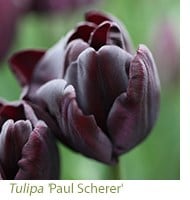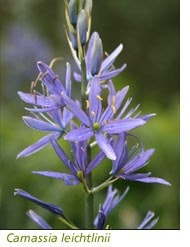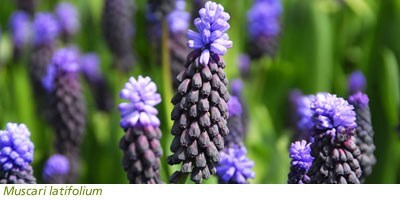One of the great things about gardening is being able to look into the future with enthusiasm, and part of that is planting now for next spring. A gardener knows, when handling papery brown bulbs, that these insignificant little things will produce early flowers worth their weight in gold. Furthermore spring-flowering bulbs can shine in the smallest plot, even in a container by a door. Or they can flow through a lawn, or float above a border, because each bulb is already primed to flower. You simply can't go wrong.
When to Plant
 Plant alliums, daffodils, scillas, crocus, muscari, snowdrops, winter aconites (Eranthis), erythronium, outdoor hyacinths and lilies in September and October. Plant alliums, daffodils, scillas, crocus, muscari, snowdrops, winter aconites (Eranthis), erythronium, outdoor hyacinths and lilies in September and October.
 Tulips are the exception though. They are planted once the temperatures fall because they are prone to a fungal disease called tulip fire (Botrytis tulipae), which spreads more easily in warm weather. This stunts the bulbs, and streaks the foliage and flowers in unsightly whitish-grey marks. If you succumb you will have to leave a gap of five years before planting in the same place again. For this reason tulip bulbs must be planted in colder weather, usually from November right up until Christmas. Some gardeners prefer to plant them in containers to lessen the chance of getting the disease in their soil and tulips do shine, lifted up to new heights in weather-proof containers. Tulips are the exception though. They are planted once the temperatures fall because they are prone to a fungal disease called tulip fire (Botrytis tulipae), which spreads more easily in warm weather. This stunts the bulbs, and streaks the foliage and flowers in unsightly whitish-grey marks. If you succumb you will have to leave a gap of five years before planting in the same place again. For this reason tulip bulbs must be planted in colder weather, usually from November right up until Christmas. Some gardeners prefer to plant them in containers to lessen the chance of getting the disease in their soil and tulips do shine, lifted up to new heights in weather-proof containers.
How to Plant
The rule of thumb is to plant them between twice and three times the depth of the bulb. A small trowel or bulb planter is useful.
 When naturalising in grass it is useful to lift two sides of a triangle of turf (30 x 30cm) with a spade so that you have a v-shaped flap of grass attached to the main sward. Take a fork and carefully break up the newly exposed triangle of soil that was under the grass. Plant your bulbs in the triangle and then pull the flap of grass (that is going to cover them) with your hands to break it up a little. This will make it easier for the bulbs to penetrate the grass when they start growing in late winter and spring. Tread it back down carefully - it may look a little bumpy to start with, but will soon settle. Camassia leichtlinii does very well in grass, generally following daffodils with spires of deep-blue stars studded with upturned yellow anthers. When naturalising in grass it is useful to lift two sides of a triangle of turf (30 x 30cm) with a spade so that you have a v-shaped flap of grass attached to the main sward. Take a fork and carefully break up the newly exposed triangle of soil that was under the grass. Plant your bulbs in the triangle and then pull the flap of grass (that is going to cover them) with your hands to break it up a little. This will make it easier for the bulbs to penetrate the grass when they start growing in late winter and spring. Tread it back down carefully - it may look a little bumpy to start with, but will soon settle. Camassia leichtlinii does very well in grass, generally following daffodils with spires of deep-blue stars studded with upturned yellow anthers.
Once your bulbs are established make sure that you do a thorough tidy in early September, just before your dormant bulbs begin to re-root and grow again.
The Aesthetics

When arranging bulbs it’s best to plant the earlier flowering bulbs (such as daffodils, muscari and crocus) away from later-flowering tulips. Otherwise by the time your tulips flower, the daffodils etc. will be over and may spoil the show by looking ragged.
Always go for a natural look and avoid planting in straight lines or blobs. If using only one variety randomly sprinkle them across the ground and plant where they fall so they are close together, but not right next to each other. Using one variety of any bulb shortens the show however as they will all flower at the same time, giving only two weeks of flower in an average year. For this reason it’s a good idea to combine four or five varieties (or more) of each type of bulb, some earlier and some later. Then it’s possible to have early spring bulbs from January until May. The best way to extend your display and make it look good is to restrict yourself to three or four varieties, but plant them in quantity to avoid a pincushion effect.
|








